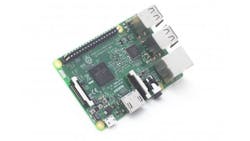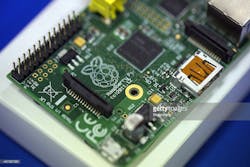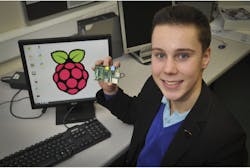Can Raspberry Pi 3 Democratize Advanced Tech Revolution? Yes!
Every year, math geeks everywhere gather round in a circle on March 14 (3/14) to celebrate Pi Day. IoT geeks can now celebrate Feb. 29 as Raspberry Pi Day, thanks to the release of the Raspberry Pi 3 ($35), the latest version of the credit-card sized single board computer that democratizes modern computing.
Four years ago, the U.K.-based Raspberry Pi Foundation launched the 256MB Raspberry Pi Model B. Since then, Raspberry Pi, widely used an educational tool, has sold 8 million units. New features include built-in WiFi and Bluetooth LE, and a 1.2GHz 64-bit quad-core ARM Cortex-A53 CPU.
That upgraded CPU from Broadcom gives it 10 times the performance of the initial version and 50% more processing power than Raspberry Pi 2, which also costs $35. This third iteration has complete compatibility with Raspberry Pi 1 and 2.
These upgraded features seem to indicate that the device can now be used not only for teaching, but for innovating.
"The new Raspberry Pi opens up even more possibilities for IoT and embedded projects," founder Eben Upton told the BBC.
Any number of IoT or robotics projects can utilize the Raspberry Pi 3. The 85x56x17-mm board contains 4 USB ports, one HDMI port, and one Ethernet jack. It boots from a Micro SD card and runs a Linux OS or Windows 10 IoT.
Buy the Raspberry Pi 3 here
A logo sits on the printed circuit board (PCB) of a Raspberry Pi single-board computer following assembly at Sony Corp.'s technology centre in Pencoed, U.K., on Monday Dec. 16, 2013. Raspberry Pi, a low-cost computer designed primarily for children, was developed in the computer laboratory of the University of Cambridge. Photographer: Simon Dawson/Bloomberg via Getty Images
This Raspberry Pi could very well be the IoT equivalent to the printing press, inasmuch as it allows anyone of any geographical or socioeconomic background to harness its power.
No longer will you need to live in Silicon Valley to leverage IoT technology, or start a software company, says Marc Blackmer, Cisco’s Product Marketing Manager for Industry Solutions.
"Now you can get a bunch of people with Raspberry Pies and connect them to the Internet with people who are working on similar projects," he says. "You don’t have buy racks full of servers. You have this $35 credit card sized computer at your hand. There’s so much now that can be done. It’s the democratization of innovation."
That might not be great news for the tech startups ingénues who are better at charming (or b.s.-ing) angel investors than creating revolutionary devices. For the quiet kid spending hours after school tinkering with servos and microprocessors, it’s the key to unlocking the next big thing.
"It goes more toward a meritocracy," Blackmer asserts. "The more minds that are cranking away out there, the more things are going to come out of left field that we never thought possible."
One of these minds cranking away is Matt Timmons-Brown, a computer science protégé known as "TheRaspberryPiGuy" on Youtube. The 16-year-old has attracted nearly 50,000 subscribers to his channel, which offers technical tutorials on Raspberry Pi. He started it at 13, and has received more than 3.5 million total views.
He started "playing around" with the original Raspberry Pi at 12, though it took some time to get used to the technical jargon, he revealed at a speech he gave for tech company ARM in Cambridge, U.K.
"I powered through and tried my best to learn about Python, robots, electronics," he explained. "Soon enough I was flashing LEDS and controlling motors with my Raspberry Pi."
Matt Timmons-Brown at age 14, showing off the Rasberry Pi. His tutorial videos on the credit card-sized computer have garnered 3.5 million views.
Photo credit: Cambridge News
He used his experience to make the learning process easier for other IoT novices. He recently wrote on his channel: "The Raspberry Pi changed my life in a very profound way, igniting a passion for computer science, programming and electronics that just was not there before. This credit-card sized computer made learning about tech easy and accessible. Not only did it kickstart my interests, but it also sparked the same passion for computer science in millions of others."
How these upstarts will change the world, no one yet knows.
But there is one thing to think about: Millennials are distinguished as being the first generation to grow up completely with the Internet.
Besides being the largest demographic in the workforce, they have also been the most maligned, and most likely to take a selfie while eating. Timmons-Brown’s generation will be the first to be fully immersed in the language of IoT.
As good as Millennials are at navigating Tinder and Instagram, maybe this generation on deck will be as good programming the robots to care for their grandparents or running smart farms with an army of agricultural drones.
Feel free to predict what's on the innovation horizon in the comment section below. Here's a video Timmons-Brown made (naturally) that shows off what Raspberry Pi has done in four years WITHOUT the built-in Bluetooth and WiFi to give you some ideas of what's next:
About the Author
John Hitch
Editor, Fleet Maintenance
John Hitch, based out of Cleveland, Ohio, is the editor of Fleet Maintenance, a B2B magazine that addresses the service needs for all commercial vehicle makes and models (Classes 1-8), ranging from shop management strategies to the latest tools to enhance uptime.
He previously wrote about equipment and fleet operations and management for FleetOwner, and prior to that, manufacturing and advanced technology for IndustryWeek and New Equipment Digest. He is an award-winning journalist and former sonar technician aboard a nuclear-powered submarine where he served honorably aboard the fast-attack submarine USS Oklahoma City (SSN-723).



